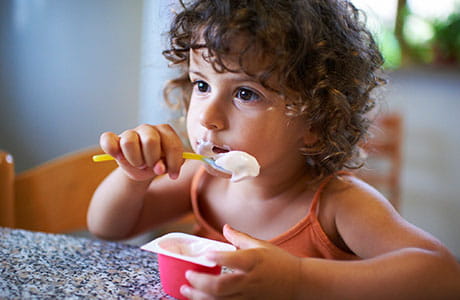Back to school: Tips for keeping kids healthy
Our pediatrician-approved tips will help keep your child healthy from the first day of school to next summer vacation.
Who doesn’t remember the excitement you felt on the first day of school?
This year, as your kids reconnect with the classroom, you can help them ward off sniffles, tummy aches and the bigger stuff, like flu, so they can make the most of day one — all the way through to summer break.
Just follow a few simple tips from Kati Kostyak Eisenhuth, MD, pediatrician at Geisinger Healthplex State College, who’s been keeping kids healthy for over a decade.
Ways to keep your kids healthy at school this fall
When it comes to keeping your kids healthy in school, the key is preparation. That means teaching them a few tricks at home, packing their backpacks and messenger bags with the tools they’ll need — and giving them a literal shot in the arm.
Dr. Eisenhuth suggests taking these steps:
1. Get your child current on their vaccines
If the pandemic put a pause on your family’s well-visits, here’s your reminder to schedule them — especially before your child heads back to the classroom.
After age 4, your child should see their pediatrician each year for a well-visit. Along with checking your child’s overall health, your pediatrician will make sure they’re up to date on necessary vaccines.
Some immunizations are required by law in Pennsylvania. But you can opt for extras that are like a shield for kids entering classrooms where, let’s face it, surfaces can get germ-y.
“Vaccines are the best way to protect your child against potentially serious diseases, like measles, polio and COVID-19,” says Dr. Eisenhuth. “Make sure your child has all the immunizations they need.”
2. Help them raise a (clean) hand
Frequent handwashing is one of our best defenses against getting sick — from pink eye to the flu and COVID-19. So, teach your kids good hand hygiene habits (here’s a handy guide). And, if they’re young, wash with them a few times to be sure they’re doing it the right way.
"Touching a surface and then touching their face, mouth, nose or eyes is the most common way kids encounter the germs that make them sick," adds Dr. Eisenhuth. “So, encourage them to wash — wash often and wash well.”
3. Pack a hand sanitizer in their bag
While washing hands with soap and warm water is the best way to combat the germs that can make us sick, it may not always be possible for your child to hit the sink. For those times, using a hand sanitizer with at least 60% alcohol is a great solution.*
One way to increase the odds your kid actually uses their sanitizer? Take them shopping with you. With so much fun packaging — and kid-friendly scents — available, you’re sure to find one they might actually like showing off and squirting on.
*Make sure their sanitizer doesn’t contain methanol, as per FDA guidelines.
4. Cough and sneeze like Dracula
Teach your child to cough and sneeze into their bent elbow instead of their hands. “We often say ‘cough into your chicken wing’,” adds Dr. Eisenhuth. “The position looks a lot like Dracula pulling his cape across his face, which makes it fun and easy to remember, especially with Halloween approaching.”
This practice will keep germs off their hands and makes it less likely that they’ll spread to another child or a surface that everyone touches.
5. Catch sneaky illnesses early
Some conditions — like the ones below — are more common among kids than adults. Keeping these nuisances top-of-mind lets you watch for signs and intervene early.
- Head lice: Lice can cause an itchy scalp, red bumps on the head and neck, irritability, difficulty sleeping and white particles (lice eggs) in the hair.
- Hand-foot-mouth disease: This condition can cause sores in the mouth and blisters on the hands and feet.
- Fifth disease: Also called "slapped cheek syndrome," Fifth disease causes a rash on the cheeks and may be accompanied by a low-grade fever.
- Pink eye: Pink eye causes the whites of the eyes to become pink or red, often with watery, green or white discharge. The infected eye may be itchy or painful.
"These illnesses can cause a lot of discomfort,” says Dr. Eisenhuth. “Some can be treated at home with over-the-counter treatments, while some require prescriptions.”
If you recognize any of these symptoms, call your pediatrician.
6. Know when to keep your child home from school
You and your child followed the tips — but they still catch something. While it’s always a good idea to keep your child home from school if they aren’t feeling well, it’s especially important as COVID-19 (and its variants) are still spreading. If your child is sick, keeping them home not only allows them to recover, but also keeps them from spreading germs to others.
As a general rule of thumb, keep them home if they:
- Run a fever
- Have a cough
- Vomit more than once
- Have frequent bouts of diarrhea (more than 3 loose stools in 24 hours)
- Complain of joint pain or muscle aches
- Complain of chills or shaking shivers
- Have an unexplained rash
- Are unable to eat and drink normally
- Are unable to concentrate on schoolwork due to not feeling well
"When in doubt, it’s probably best to err on the side of caution and keep your child home," says Dr. Eisenhuth. "And don’t hesitate to call your pediatrician for advice.”
Next steps:
Hit me with your best shot: 7 vaccine myths debunked
Find a pediatrician near you




